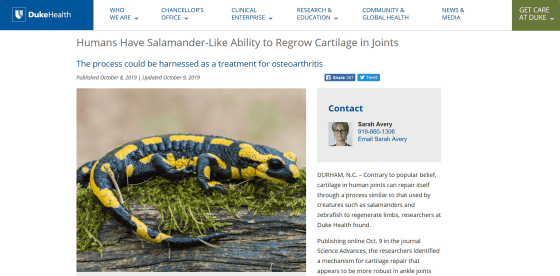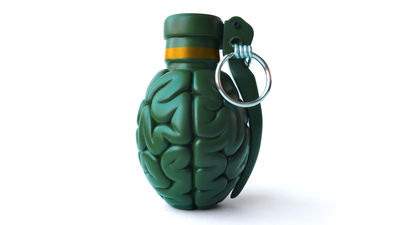It turns out that the human body has `` reproduction ability like a salamander that reproduces even if it is cut ''

by
Some animals, including salamanders, have the ability to regenerate even if their limbs are severed. Researchers have discovered that cartilage in human joints has regenerative capabilities similar to salamanders.
Analysis of “old” proteins unmasks dynamic gradient of cartilage turnover in human limbs | Science Advances
https://advances.sciencemag.org/content/5/10/eaax3203
Humans Have Salamander-Like Ability to Regrow Cartilage in Joints | Duke Health
https://corporate.dukehealth.org/news-listing/humans-have-salamander-ability-regrow-cartilage-joints

The research team of
This technique utilizes the fact that new proteins made in tissues have almost no amino acid conversion, while old proteins have many amino acid conversions. Using this mechanism and high-sensitivity mass spectrometry, the research team identified how young or old human cartilage containing collagen is.
As a result, it turned out that the age of the cartilage greatly depends on where it is located in the body. The ankle cartilage is young, the age of the knee joint is older than the ankle, and the hip joint is older than the knee joint. Sites that have a strong ability to regenerate cartilage in humans also correspond to areas with strong regeneration ability such as salamanders. This discovery explains why hip injury takes longer to recover and sometimes develops into chronic arthritis, while ankle damage recovers relatively quickly.

by
Researchers have also studied a molecule called microRNA that regulates the cartilage regeneration process. MicroRNAs are active in animals with high ability to regenerate limbs and fins, such as salamanders, zebrafish , and lizards.
MicroRNAs in humans have been helpful in repairing joint tissues, and like other animals, microRNA activity varied greatly from site to site. The team says that in humans, microRNAs were active in the knees rather than the hips and the ankles than the knees, and were more active in the shallower layers than the deeper layers of cartilage.
Hsueh said, “We were very excited to learn that the regulators found in salamander limb regeneration look like a controller that repairs human joint tissue.” “We've called this function 'inner salamander'capacity (Internal salamander ability) 'and commented.

by
The research team pointed out that this discovery may lead to the treatment of osteoarthritis , the most common joint disease. Osteoarthritis is a phenomenon in which cartilage degeneration / wear occurs due to stimulation, etc., and inflammation of the synovium surrounding the joint is accompanied by acceleration of degeneration. MicroRNAs may help prevent, delay, and treat arthritis.
'We believe that boosting this regulatory function can regenerate cartilage in inflamed joints. In addition, by understanding the regulatory factors that are lacking compared to salamanders, Kraus said It could even be able to regenerate some or all of the limbs lost due to injury, ”he said, arguing that this discovery may be a fundamental mechanism that can be applied to other human tissues.

Related Posts:







